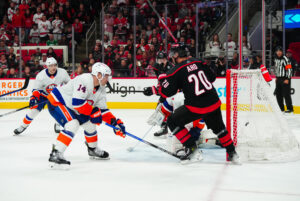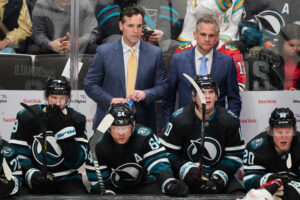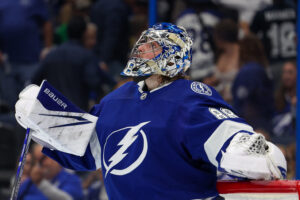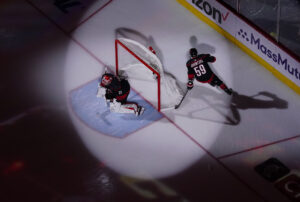In a disappointing, but hardly shocking turn in events, Elliotte Friedman revealed in a tweet that the NHL will likely have a flat salary cap of $81.5M for the next two seasons and $82.5M for the season after. To add to this, Bob McKenzie confirmed that teams would not be provided with amnesty buyouts.
So what does this mean for the Vancouver Canucks, the team that has north of $16M tied up in bottom-six players? Or better put, $16M in locker room leaders and great character guys? $4.375M for a Toews or Bergeron type of player has to be a steal.
What a Flat Cap Means for the Vancouver Canucks
The fact of the matter is, these lucrative contracts handed out in the name of leadership and character are going to result in the loss of multiple valuable assets. Add on to these contracts the Ryan Spooner buyout, the flat cap, and the disaster that is the Roberto Luongo cap recapture penalty, and it’s all doom and gloom for “Raincouver.” It’s fitting, really.
Here’s a list of expiring contracts for the Vancouver Canucks, at the NHL level.
Tyler Toffoli, Jake Virtanen, Tyler Motte, Adam Gaudette, Zack MacEwen, Chris Tanev, Troy Stecher, Oscar Fantenberg, Louis Domingue, Jacob Markstrom, Josh Leivo.
11 players, and a projected $16M in cap space. That number would have looked closer to $22.7M with the standard five percent inflator. $6.7M, that would have given the Canucks enough room to sign a couple more players. For those of you that are into analytics, $6.7M is about 1.12 little things. With this flat cap, the Vancouver Canucks find themselves in a financial bind, and in a situation where they will have to part ways with valuable assets.
Of those players mentioned, the overwhelming majority improve the team in one way or another. In other words, losing any of them will have marginal to highly significant negative impacts on the team. It’s worth noting that Leivo is a bit of a wild card as he is still rehabbing from a knee injury, but was one of the Canucks main secondary scoring options while healthy.
And of course, there’s the big names in Markstrom, Toffoli, and Tanev. The Canucks have some difficult decisions to make for the trio.
Figuring Out the Cuts
Most fans seem to have resigned (Pun intended) themselves to the fact that Chris Tanev will be in a different jersey next season, wherever and whenever that may be. If that is the case, how will the Canucks replace his minutes? Can the Canucks expect either of Brogan Rafferty or Nikita Tryamkin to step in and fill a Chris Tanev sized hole in the Canucks defense? Is Thatcher Demko ready to be the number one goalie in the NHL? Do they let Toffoli walk away in free agency and be left with nothing to show for the trade?
As many fans are suggesting, it’s certainly possible that Benning ships some goodies along with a bad contract to another team in an attempt to limit the losses in free agency. I agree with them in the sense that it’s a simple solution. Trade some prospects and some picks along with some bad contracts, and they can go on their merry way.
But here’s the thing. After trading Tyler Madden and graduating Quinn Hughes, the Canucks prospect pool isn’t exactly an embarrassment of riches. A prospect with enough promise that a team will take on a grossly overpaid veteran player? The Canucks have four, maybe five guys that fit that bill. And none of them are just a drop in the bucket. The same goes for trading draft picks.
You can’t throw in a couple of fifth-round picks with Loui Eriksson and call it a day. You’re looking at giving up picks in the early rounds. Yes, the Canucks are past that point in their rebuild where they absolutely have to hoard picks and prospects. But trading valuable assets in a cap dump is not what a team just coming out of the basement should be doing. If a team in the Canucks position is looking to trade picks and prospects, it’s going to be in exchange for other assets.
Granted, this isn’t a normal situation. However, the Canucks management absolutely cannot be clear of all blame. Here’s a good analogy. The Vancouver Canucks were handcuffed by the league and its flat cap, but the Canucks are who provided the league with the handcuffs. With proper cap management and reasonable signings, they would not be in this situation at all.
The problem isn’t that the Canucks won’t be able to clear the cap space. The problem is that they got themselves into this situation in the first place. The Vancouver Canucks are a team that haven’t made the playoffs in the last half decade. Their top two players are still on ELCs. Captain Bo Horvat, along with J.T. Miller and Brock Boeser are all making under $6M. The fact that they are in a cap crunch at this point in time is downright inexcusable.
Of course, there’s no possible way to tell exactly how things will play out. There’s no crystal ball to stare at nor will Dr. Emmett Brown appear in a parking lot and take us into the future. There’s no way for us to know what’s up Benning’s sleeve when it comes to cap management. The best that can be done is to make educated predictions given the current situation. At the end of the day though, things aren’t looking good for the Vancouver Canucks. The team is set to face the consequences of their negligent spending. It needs to be made clear, however, that the flat cap isn’t causing these issues. It’s only amplifying them. The Canucks have nobody to blame but themselves, as they prepare to make some very difficult decisions.
Main Photo:






